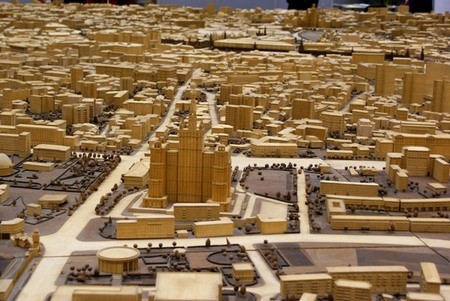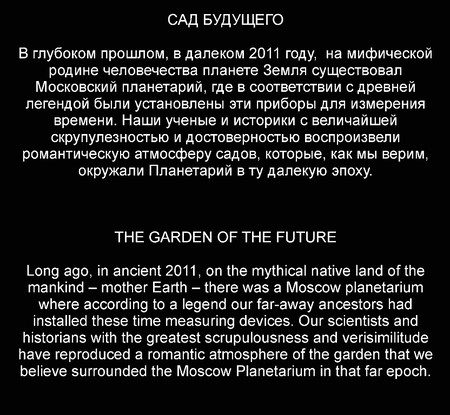The first Moscow expedition to Mars. Photo report on the exhibition
An old building located practically in the center of Moscow is known for its large wooden model of the city created in the precomputer epoch. The building is a place where annual exhibition of achievements of Moscow landscape architects is organized every autumn under the aegis of Moscow committee on architecture and town-planning.

The wooden model of the city is installed in an old building in the center of Moscow.
It fortuned that for the last year I was delineating, manufacturing and etching sundials for Moscow planetarium. Now they are just about to be installed. Before fixing sundials forever I wanted to organize them a coming-out. For a long time I had no opportunity to do that. Another very important reason to expose sundials to the public, which is far from astronomy, I will explain at the end of the story. Therefore, when my friends have invited me to take part in the annual exhibition I was delighted very much and have accepted their invitation with gratitude.
Persons, who make sundials nor just for hobby, know that people consider their profession as a kind of light insanity and themselves as extraterrestrials. Not only illiterate savages but the mankind in general think so. It is hopeless to expect it to love the daylight astronomy. We can only try to teach it with the help of the most intelligible teaching methods we can develop. Thus, I have decided to dispatch all mankind to Mars to save it from its own mistakes and give it an opportunity to fully realize how beautiful the sundials are. This is the best teaching method, I think. The architectural exhibition has given me a chance to turn this misanthropic plan into the reality.
For the sake of objectivity, I should note that the idea to resettle the mankind to Mars isn't an original one. Prior to me it was done already by Ray Bradbury, Harry Garrison and many others.
I named my installation «The garden of the future». The action is set on Mars in 15 000 A.D. An average Martian does not believe in existence of the Earth – a mythical ancestral home of mankind. However, there are Two Material Proofs preserved in The Martian Treasury. The first one is a half dilapidated Jane Austen novel with a stamp of a Sprigfield school library. Every page of it is marked by one Bart Simpson, probably the Earth President. The second one is a set of six sundials which have once been installed in the Moscow planetarium. Martians understand what the sundials might be used for. But in the Austen’s novel so called “The Tree” and “The Garden” are mentioned. After centuries of research and puzzling over the book Martians are sure that “The Tree” is a branched out piece of metal, and “The Garden” is a place where there is a lot of such branched out pieces of metal.

Poster at the entrance of the Martian garden.
As soon as I have thought up this legend I have immediately started creating the Martian landscape. It was a simple job. There are a lot of high resolution photographs on the website of the European space agency and NASA. I have them printed as 3×3 m banners and, thus, I have got a real romantic garden. I think that if Jane Austin might see it, she undoubtedly would write two tens new novels. Along with the trees made of steel there were six sundials in the garden installed onto the stainless steel pedestals. Here they are from the left to the right.

The Martian Romantic Garden of the Future
Star shaped sundial

Star sundial

South faced edge of the support of the sundial.
This is the first Russian star sundial. It has an equatorial dial and 19 dials etched on the side edges of the star rays.
Polar-equatorial sundial
This instrument has two dials – equatorial and polar. The name of this sundial is “Peter and Wolf”. It is the name of well known opera created by Russian composer Sergey Prokofiev for children. Every Russian schoolboy and schoolgirl studies this opera in primary school. All my sundials are intended to advance the children’s astronomic education. I think that children should not forget that objective sciences and subjective arts, like music, are identical ways to understand the world.

The polar-equatorial sundials “Peter and Wolf”величина дуги.

The polar plane of the “Peter and Wolf”.
The projective sundial.

The projective sundial.

The projective sundial. The double-edged arrow points the north and south poles.

Проекционные солнечные часы. Стрелка на экране указывает на северный и южный полюс мира.

The projective sundial. On the back side of the screen the equqtion of tine table is etched.
The polyhedron sundial
This instrument has 7 sundials.

The polyhedron sundial. North faced and equatorial planes...

The polyhedron sundial. North faced and equatorial planes...

The polyhedron sundial. South faced and polar planes.
Horisontal sundial combihed with south faced sundial
Two sundials have a single gnomon shaped like an arrow coming through the holes. Its name is “The Odyssey arrow” to remind to the children the ancient myth. On the back edge of south faced dial the analemma is etched.

“The Odyssey arrow”

The analemma on the back side of south faced dial.
Cylindrical equatorial sundial
This instrument has a very simple construction and difficult name. I am not still sure that this name is a proper one. Half a year ago I asked my colleagues what is the best name for this construction.

Cylindrical equatorial sundial
Bill Gottesman (www.precisionsundials.com) told that it is a polar equatorial sundial.
Patrick Powers (BSS) tends to name it equinoctial sundial.
Nicola Severino on the base of ancient literature has got a conclusion that it should be named as cylindrical equinoctial sundial with equinoctial gnomon.
Luke Coletti (Great Circle Studio and Sara J. Schechner are sure that the right name for this sundial is a cylindrical equatorial sundial.
If nobody mind let us think that the last name is a conventional one.
Thus, I have sent the mankind to Mars in order to punish it for insufficient love with sundials. My task is over. Now I tell about the reasons which make me to launch this interplanetary expedition.
Some years ago in the beginning of February the deputy director of the Moscow planetarium Stanislav Shirokov phoned me and made an appointment with me. It was not a piece of news to me that for the recent years the Moscow planetarium was closed. From newspapers I knew that building repair is stopped for the lack for money. Moscow is a northern city and it is nearly the night in February at 5 p.m. I went along a snow-covered dark lane, trying to imaging the reason the deputy director is waiting for me.
From outside the Planetarium building looked like a Hollywood pavilion constructed for post-futuristic movie about consequences of nuclear war. Shirokov has met me at the entrance. When we exchanged greetings, somewhere on-neighborhood, absolutely close, the wolf howl was suddenly heard. The Moscow planetarium has a common fence with the Moscow zoo. Those who have read the books by Farley McGill Mowat know that February is the love time to wolves. And here, in the center of dark, snow-covered Moscow wolves howled behind iron lattices dreaming about love and freedom. The huge hall of the Planetarium had no borders. We went by the unfinished walls and bottomless precipices towards a distant dim light source. I expected occurrence of vampires but they haven't appeared.
Shirokov asked me to sit down in an armchair. We have a tee a talked about stars, galaxies, and black holes and about the sundials which he asked me to make.
It was hard times after the World War 2 when Shirokov, just a schoolboy, came to the Planetarium for the first time. He came there and he forever had fallen in love with the star sky. He worked for Moscow planetarium for the whole life. Thousands of Moscow scientists are his students. It was his dream to make the Planetarium the best one in the world. Now this dream is almost the reality. Moscow government makes everything to achieve this aim. The best equipment and instruments are already installed. Construction works are coming to the finish and the planetarium waits for the first visitors in the nearest future. Shirokov will not see the result of his work. This 2010 year he has died in the day of spring equinox.
I devote this interplanetary expedition to the great scientist and teacher Stanislav Shirokov and to boys and girls who, like he, will come to the Planetarium soon and will fall in love with the star sky for ever.

Stanislav V. Shirokov, 1932 — 2010

Schoolboys and schoolgirls in Moscow planetarium, 1959. Photo by ТАСС.
Schoolboys and schoolgirls in Moscow planetarium, 1959. Photo by ТАСС.